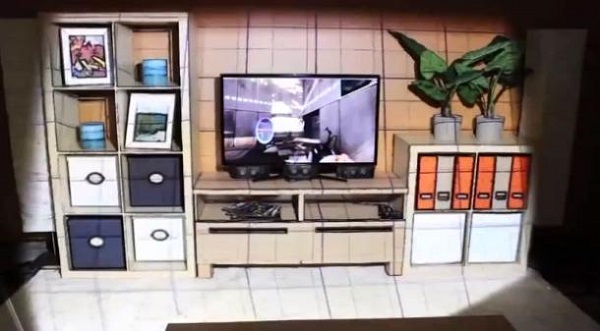The new video explaining the features of IllumiRoom in great detail specifies that the projector needs to be placed on a coffee table. Not a chair, not a cardboard box, but specifically a coffee table.
This is probably the first time in recorded history that the launch of a video game console peripheral will increase the sales of coffee tables. On a more serious note, it seems that Microsoft really knows how to perfect its concepts and how to turn them into real, vendible products. When I first wrote about IllumiRoom, it was nothing more than a proof of concept. At least that’s what Microsoft wanted us to believe when it showcased the room-filling projector at CES, earlier this year.

In the meantime, the Redmond company sent out the invitations for the launch of the next-gen Xbox and released a new video in which the IllumiRoom gaming modes were revealed. In these circumstances, it is rather safe to assume that the new console will pack the IllumiRoom projector at least as an optional device, much like the Kinect was in the case of Xbox 360.
According to the new video that has been recently released by Microsoft, IllumiRoom connects to the Xbox wirelessly. That’s quite fortunate, as wires surrounding the coffee table would not be aesthetic, not to mention the chances of tripping.
Speaking of tripping, the experience is quite immersive, to say the least, and the whole setup makes you feel like you’re in a different world. After placing the projector on the coffee table and connecting it to the Xbox, the ultra-wide field-of-view device will start scanning your room in order to determine where the TV set is. This needs to be done in order to block out a part of the projection, so it does not overlap. The IllumiRoom prototype includes a Kinect sensor that captures the color and the geometry of the room. Hopefully, the final version of the product will include the Kinect cameras in the same body as the projector.
The calibration is performed automatically and is independent of the design of the room, as shown in the following video. The projected illusions fit in several different categories. First of all, you will have the possibility to extend the content from the TV set onto the walls. Another option is to focus on the high-contrast features. In this scenario, only the guidelines of the buildings are displayed, when playing a FPS. Also, when playing an FPS, you will be able to select what elements escape the TV screen, the weapon’s fire being one of the options.
Key elements from the game can be projected in the room, so that the player doesn’t miss them. It is also possible to mask parts of the projection. This feature is particularly useful when watching movies (guess that’s why Microsoft intends to include a Blu-Ray drive in its next-gen Xbox). One of the most interesting things is the ripple effect that is projected on the walls when firing a gun. If abstract illusions are your thing, then IllumiRoom will let you project those, too!
To work with the content that you’re going to play or watch, Microsoft needs to have access to the source code and rendering of the games and/videos. Otherwise, the projector needs to guesstimate the context, but the results are pretty satisfactory in this case, as well. We’ll have to wait and see how the IllumiRoom device looks and works in a real-world scenario, but by the looks of it, it will be fantastic!
If you liked this post, please check the initial announcement of the Microsoft IllumiRoom proof of concept and the official launch date of the Xbox 720.










